|
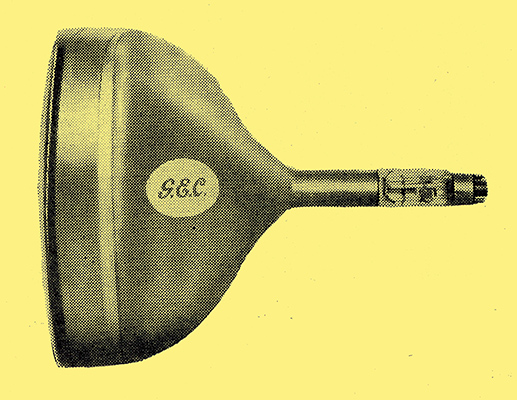
Experimental GEC 17 inch CRT with 90° deflection angle.
Following the general acceptance of 21-inch cathode-ray tubes in television receivers, the latest trend in design has been to shorten the length of the tube by increasing the normal 70° scanning angle to something like 90°. The examples of this reported last year have now been joined by two more 21-in tubes, from GEC and Mullard respectively. Both operate with about 16kV on the anode, for which the grid cut-off voltage is between -40V and -80V, and they have 6.3V, 0.3A heaters and external conducting coatings. The GEC tube, however, has a triode gun while the Mullard is a tetrode.
Of course, this increase in scanning angle brings with it considerable problems in design. In the first place, the small change from 70° to 90° demands a somewhat disproportionate increase in scanning power of about 50%. Within the tube itself the electron beam is liable to be interrupted by the glass wall at maximum deflection, producing corner cutting of the picture. In addition, with the approximately flat faces now being used, the beam strikes the screen at increasingly acute angles towards the edges and so has a tendency to be defocused there.
These troubles have to be overcome partly by the design of the external deflection system and partly by the electrostatics of the internal electrode structure. In the Mullard tetrode gun, for example, an extra electrode at about cathode potential is used to obtain optimum uniformity of focus over the whole screen, and it appears that this uniformity is achieved at the expense of 'spot smallness' in the centre. The desired condition is produced when the extra electrode is zero or slightly negative with respect to the cathode. If the voltage on it is increased the spot size in the centre of the screen is certainly reduced, but inferior focusing is obtained at the edges. However, the necessary sacrifice in 'spot smallness' at the centre is largely offset by the reduction obtained in the length of the tube: this causes the magnification of the focusing 'lens' to be less than with a normal-length tube, so that the image formed on the screen (i.e. the spot) of the electron cross-over point in the gun is smaller than usual.
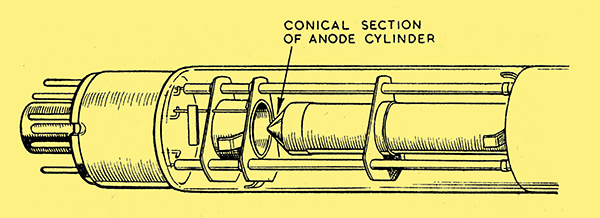
Conical part of anode in GEC 21-inch 90° CRT for obtaining uniformity of beam focus.
In the triode gun of the GEC tube the improvement in uniformity of focusing is obtained by a conical section at the cathode end of the long anode cylinder (see illustration). This works by eliminating the bulging equipotential lines of electrostatic field which in normal anode structures have a divergent effect on the electron rays of the beam. The criterion in all such systems, however, is that the beam diameter should be as small as possible within the deflector coils.
Generally speaking the reduction in length achieved by the increase from 70° to 90° scanning angles is about 3 inches and this is quite a help in the mechanical design of the big 21-in sets. It seems, however, that there is still scope for the same method of reducing length on the popular 17-in tube, and GEC have been trying it out on an experimental basis. It will be remembered that their first introduction of the 90° scanning angle was in a tube as small as 12 inches. The experimental 17-in tube is similar to their existing type 7401A except that it has the 90° angle instead of 70°.
Small tubes are, of course, in the minority nowadays, but a new 12-in type was shown by Ediswan, the CRM124. This incorporated the improved type of ion-trap developed by Ediswan which traps positive ions, as well as the negative ones by means of a slanting electrostatic lens formed between the first and final anodes. Ediswan also have a new 14-in rectangular tube, the CRM143, which has similar characteristics to the CRM124.
Aluminizing now seems to be a common feature of almost all cathode-ray tubes. The main reasons for it are well known, but it has other advantages which are perhaps not so familiar. In manufacture, for example, it has been found that the variations in screen brightness from tube to tube do not have such a wide range, or 'spread', when aluminizing is used, so that fewer of the aluminized tubes are likely to be rejected as being outside the required limits than the non-aluminized types. In addition, aluminizing overcomes the effect known as 'mottling' on the non- aluminized screens.
No significant developments in receiving valve design have taken place since our review in June this year, except that Ediswan and Ferranti were showing their versions of the Band-III 'front end' types which have now become so familiar.
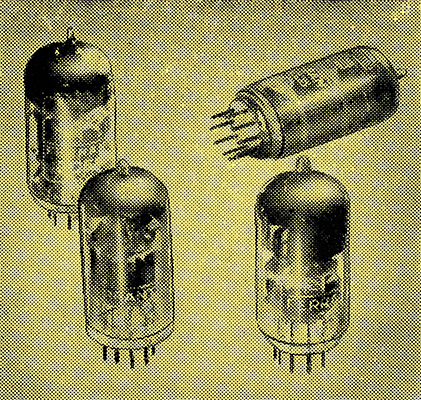
Ferranti valves for Band-III television reception.
A new 'magic eye' tuning indicator, the Brimar EM85, however, was notable, for having a screen which is viewed through the side of the bulb. It is suitable for FM receivers and can be mounted on a travelling cursor on the tuning system. Incidentally, Brimar have recently produced a new Brimistor current-limiting element, the CZ10, for use as a protective device in the filament circuits of mains/battery receivers using the latest 25 mA valves.
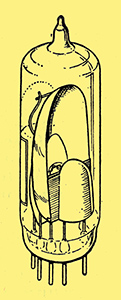
Brimar EM85 side display tuning indicator.
In transmitting valves, English Electric have extended their range of travelling-wave tubes to include 13 different types, N1001 to N1013. These valves are notable for their ability to amplify over bandwidths up to 1,000 MHz.
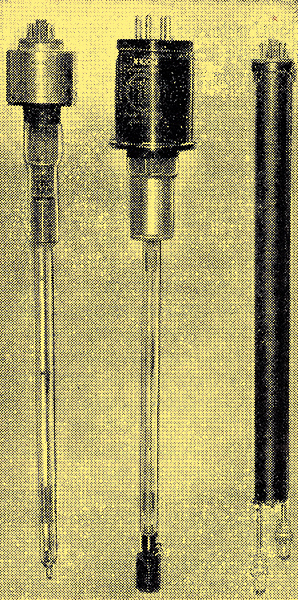
English Electric travelling-wave tubes N1013, N1004 and N10I2.
Ediswan had a new radiation-cooled triode, the ES1001, designed for use in industrial heating equipment. Its maximum anode dissipation is 1kW at 40 MHz. This firm were also showing their 'Vapotron' industrial valve (characterised by a water-vapour cooling system) which is now known as the ESV892. A new 'packaged' magnetron for the 3-cm band made by Mullard operates in the frequency range 9345-9405 MHz and has a peak output power of 250 kW. Maximum anode voltage and current are 23 kW and 27.5 A respectively.
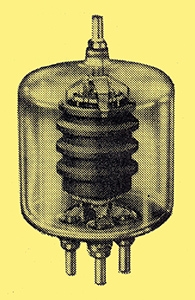
Ediswan ES1001 industrial power triode.
Mullard also had a new transmitting tetrode of all-glass construction, the QY3-65, with a maximum operating frequency of 250 MHz and an anode dissipation rated at 65 Watts. It can be used as an RF driver, power amplifier, power oscillator or as an AF power amplifier.
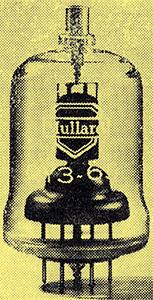
Mullard QY3-65 transmitting tetrode.
|